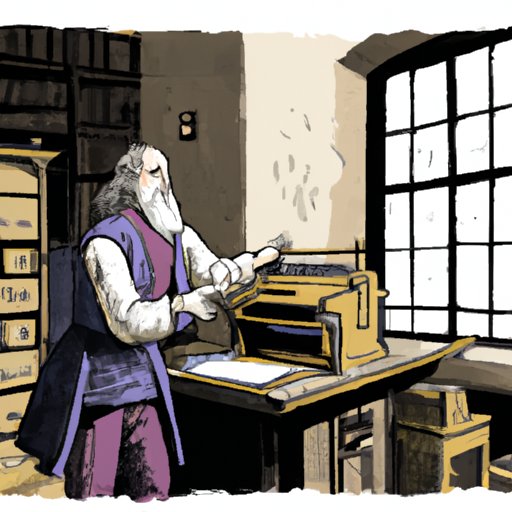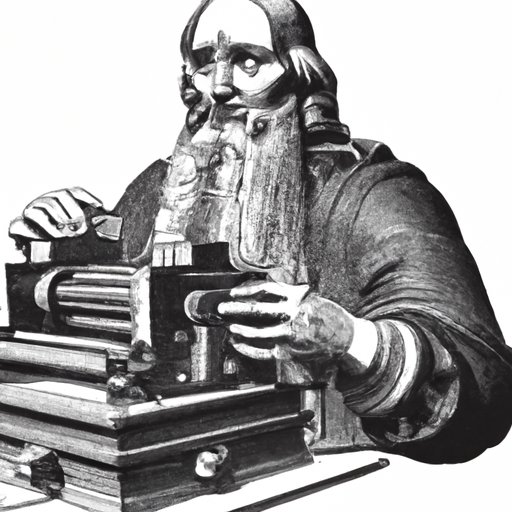Introduction
The invention of the printing press was a revolutionary moment in human history, transforming how information was shared and impacting literature, art, and culture around the world. But who was the inventor behind this remarkable invention? This article will explore the mystery of the first printing press and the man behind it: Johannes Gutenberg.
Who Invented the First Printing Press?
The invention of the printing press is often credited to Johannes Gutenberg, but the true origin of the device is still debated by scholars today. Although there is evidence of earlier versions of the printing press throughout Europe, the technology developed by Gutenberg during the mid-15th century was the most advanced of its time. It was capable of producing copies of texts more quickly and cheaply than any other method before it.
It is believed that Gutenberg drew inspiration from the Chinese invention of movable type, which used individual characters or symbols that could be arranged and rearranged to produce different texts. He adapted this technology by creating a system of interchangeable metal blocks that could be used to create multiple copies of the same text. This form of printing revolutionized the way books were produced and allowed for the mass production of books, newspapers, and other printed materials.

Revolutionizing the World: The Man Behind the First Printing Press
So what motivated Gutenberg to invent the printing press? According to historian Elizabeth Eisenstein, Gutenberg “was a man with an eye to the future, one who recognized the potential of his invention to change the world” (The Printing Revolution in Early Modern Europe, 2005). He was an innovator who saw the potential in a new technology and wanted to use it to make a difference.
Gutenberg also had a knack for engineering and design. He was able to develop a complex set of machinery and tools that would eventually become the printing press. His detailed plans included the creation of a press that could apply pressure evenly to sheets of paper and a type-casting system that could rapidly produce hundreds of copies of the same text.
What made him stand out among other innovators was his ability to combine both the technical and artistic aspects of the printing process to create a fully functional machine. By doing so, he revolutionized the way books were printed and distributed, making them more widely available.
From Gutenberg to Now: Examining the Origins of the Printing Press
Since Gutenberg’s invention, the printing press has continued to evolve over time. For centuries, the technology remained largely unchanged until the 19th century when steam-powered presses began to be used to produce larger quantities of printed material. In the 20th century, the introduction of offset printing allowed for even faster production of printed materials.
Today, the printing press is still used to produce books, newspapers, magazines, and other printed materials. However, due to the rise of digital media, the demand for printed materials has decreased significantly. Despite this, the printing press continues to play an important role in the production of physical books and other printed materials.
How Gutenberg’s Printing Press Changed the Way We Communicate
Gutenberg’s invention of the printing press had a profound impact on communication and knowledge sharing. Before the invention of the printing press, books were limited in their availability and expensive to produce. With the introduction of the printing press, books became more widely available and affordable, allowing for greater access to knowledge.
The printing press also transformed the way literature and culture were disseminated. Books became the primary source of information and ideas, and they played an important role in shaping public opinion and influencing social and political discourse. Through the printing press, authors were able to share their stories, ideas, and opinions with a wider audience.
Conclusion
In conclusion, the invention of the printing press by Johannes Gutenberg was a revolutionary moment in human history. He was an innovator who saw the potential in a new technology and wanted to use it to make a difference. His invention had a profound impact on communication and knowledge sharing, making books more widely available and accessible. Today, the printing press continues to play an important role in the production of physical books and other printed materials.
Gutenberg’s invention of the printing press was a major milestone in the advancement of human civilization. It enabled people to communicate and share knowledge more easily, and it continues to shape our culture and society in many ways. The legacy of Gutenberg’s invention lives on, and its impact can still be seen in the world today.
(Note: Is this article not meeting your expectations? Do you have knowledge or insights to share? Unlock new opportunities and expand your reach by joining our authors team. Click Registration to join us and share your expertise with our readers.)
